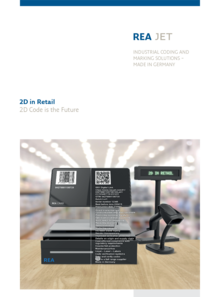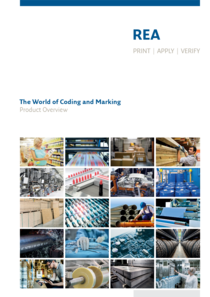2D-kassakod med GS1 Digital Link
Standardiserade streckkoder som EAN-13 eller UPC-A har revolutionerat logistiken och detaljhandeln. Nu står en ny revolution för dörren. Företag över hela världen moderniserar sina förpackningar och sin märkning av produkter och förbättrar hela informationsflödet genom att skriva ut 2D-koder.

Hittills har streckkoderna EAN-13 använts som kassakoder inom detaljhandeln och logistiken. Men på grund av deras mycket begränsade datakapacitet och den ökande anslutningsmöjligheten är de helt enkelt inte längre de senaste. Tillverkarna förväntas i allt högre grad tillhandahålla produktinformation på ett enkelt och lättillgängligt sätt. Det kan vara för konsumenter som vill veta mer om en viss produkt eller för grossister och detaljhandlare som vill optimera sin effektivitet genom att få tillgång till korrekta produktdata och information om leveranskedjan.
En standardiserad lösning för digital produktmärkning som utvecklats av GS1-organisationen kombinerar befintliga GS1-standarder med en ny universell kod - GS1 Digital Link. Med den nya GS1 Digital Link-standarden länkas GS1-identifierare - som GTIN - till Internet. Med den nya standarden kan olika information om en produkt göras tillgänglig på ett flexibelt sätt via en enda länk. Det innebär att informationen kan anpassas när som helst utan att man måste förnya databäraren, till exempel QR-koden, och dess innehåll.
Befintliga GS1-identifierare, t.ex. GTIN, förblir giltiga och bäddas in i en standardkompatibel URL för varumärkesägaren.
Sedan 2021 har GS1 2D DataMatrix, QR-koden med GS1 Digital Link och DataMatrix-koden med GS1 Digital Link godkänts som kassakoder på försäljningsstället. Migrering till GS1 Digital Link kan genomföras utan större förändringar av befintliga system och processer. Målet är att uppnå en världsomspännande migration till 2D-kassakoder senast 2027.

GS1 Digital Link kan användas med alla typer av 2D-koder - men vanligtvis med en QR-kod. Konsumenterna kan sedan använda sin smartphone för att skanna QR-koden på produktförpackningen, som omdirigerar dem till en definierad webbplats. Beroende på användaren kan olika information visas på olika språk och i olika format. Detta beror på att det konceptuellt sett är en och samma 2D-kassakod som används. Men olika appar leder användarna till helt olika destinationer. En app ger till exempel konsumenterna utökad produktinformation som ursprung, ingredienser eller bäst före datum (BBD). Med andra appar är det återigen möjligt att främja åtgärder för kundlojalitet genom interaktioner med appen, tävlingar eller rabattkampanjer. Och för tillverkaren kan samma kod ge information för processtyrning, t.ex. lagerhantering, spårbarhet, produktionsplanering och riktade återkallelser.

Strukturen
Hur ser en QR-kod med GS1 Digital Link ut?
För att sammanfatta kort: GS1 Digital Link sätter GS1-ID:n i ett webbvänligt format som vanligtvis kan kodas i en QR-kod.
I det här exemplet är flera datainnehåll länkade i en GS1 Digital Link och kodade i en QR-kod. Informationen som är inbäddad här är GTIN 04270001108739, batchnumret Lot1, serienumret 12345 och utgångsdatumet 31.12.2022.

Denna 2D-kod är därför mycket mer än bara en 2D-kod för kassan på försäljningsstället. Förutom GTIN som ett tydligt identifierbart artikelnummer kan konsumenterna via sin smartphone komma åt internet och få relevant information, till exempel bäst före datum - alltid uppdaterad och i realtid.
Användningsområdet för den nya GS1 Digital Links är enormt. De kan användas under hela produktens livscykel och inom alla delar av ett företag. I möbelindustrin, till exempel, säkerställer 2D Data Matrix-koder (DMC) moderniseringen av förpackningar och märkning av produkter.
Användningsområden och mervärde är bland annat
- Lagerhantering: upprätthållande av FIFO, lagerprecision, insikt i tillgänglighet, insikt i plats, undvikande av avfall, säkerställande av färskhet
- Spårbarhet: produktautentisering, ingrediensernas ursprung, transparens i leveranskedjan, konsumentförtroende
- Säkerhet: varumärkesintegritet, förhindra försäljning av utgångna eller återkallade produkter, bekämpa förfalskning
- Hållbarhet: information om återvinning, främjande av cirkulär ekonomi, förebyggande av avfall, från producent till konsument
- Konsumentengagemang: tillgång till varumärkesgodkänd information, kampanjer, recept, möjlighet att interagera med varumärket
- Förbättrad förpackning: marknadsföringsmål på förpackningen, efterlevnad av regelverk, förbättrad konsumentupplevelse
Några branscher som använder den nya GS1 Digital Link Standard inkluderar:
- Hälso- och sjukvårds- och läkemedelsindustrin (global standard, delvis lagstadgad)
- Fordonssektorn
- Livsmedelsindustrin
- Tekniska industrier
- Logistik och förpackning
- Onlinehandel
- Mode-, sport- och textilindustri
- Möbelindustri

Upptäck de mångsidiga användningsmöjligheterna med våra innovativa lösningar för kodning och märkning, som hjälper till att förbättra hela informationsflödet genom att skriva ut 2D-koder.


Högupplösta bläckstråleskrivare, lasersystem och teknologi för etikettering
Vilket system för kodning och märkning är lämpligt för att skriva ut GS1 2D DataMatrix-koder, QR-koder med GS1 Digital Link och DataMatrix-koder med GS1 Digital Link?
CIJ teknologi har använts inom många områden under de senaste åren. På grund av den låga utskriftsupplösningen uppfyller dock inte längre teckenkvaliteten dagens krav. Användningen av bläckstråleskrivare för små tecken för att skriva ut 2D-koder i god kvalitet och med höga hastigheter är endast lämplig i begränsad utsträckning, särskilt för kraven på 2D-kassaregisterkoder. Höga första inläsningstillfällen, som är särskilt viktiga på försäljningsstället, kan inte uppnås med den här teknologin.
Möjligheten är att ersätta CIJ med högupplösta TIJ teknologier, lasersystem eller etiketteringssystem.












